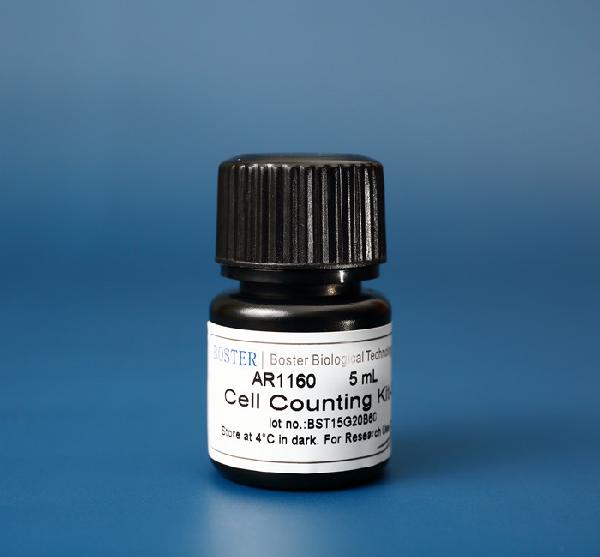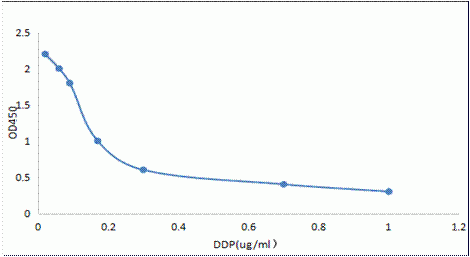Product Info Summary
| SKU: | AR1160 |
|---|---|
| Size: | 500T |
Product info
Product Overview
| Form | Liquid |
|---|---|
| Size | 5 mL (for 500 assays, 10μL per well) |
| Concentration | 6mg/ml |
| Buffer | 9% NaCl |
| Storage | Upon receipt store at -4°C, protect from light. Note: Repeated thawing and freezing causes an increase in the background, which interferes with the assay. |
| Stability | When stored as directed, product should be stable for one year. Store it at -20˚C for longer storage |
| Sensitivity | CCK-8 is the highest sensitive dye for the cell based assay. |
| Equivalent | Dojindo Molecular Technologies (Product No. CK04);
Millipore Sigma (Product No. 96992) |
Introduction
Cell Counting Kit-8 (CCK-8) allows very convenient assays by utilizing highly water-soluble tetrazolium salt. WST-8 [2- (2- methoxy-4-nitrophenyl)-3- (4-nitrophenyl)-5- (2, 4-disulfophenyl)-2H- tetrazolium, monosodium salt]* produces a water-soluble formazan dye upon reduction in the presence of an electron carrier. Cell Counting Kit-8 is a one-bottle solution; no premixing of components is required. Cell Counting Kit-8, being nonradioactive, allows sensitive colorimetric assays for the determination of the number of viable cells in cell proliferation cytotoxicity assays. WST-8 is reduced by dehydrogenases in cells to give an orange colored product (formazan), which is soluble in the tissue culture medium. The amount of the formazan dye generated by the activity of dehydrogenases in cells is directly proportional to the number of living cells. The cell proliferation assay using CCK-8 correlates well with the [ (3)H] thymidine incorporation assay. And the CCK-8 assay can also be substituted for the [ (3)H]thymidine incorporation assay. The detection sensitivity of CCK-8 is higher than other tetrazolium salts such as MTT, XTT, MTS or WST-1.
Advantages
1. One bottle, ready to use solution.
2. No organic solvents or isotopes required
3. No harvesting, no washing and no solubilization steps.
4. No Toxicity to Cell
5. More sensitive than MTT, XTT, MTS or WST-1
Precautions
1. Run pilot test to determine the optimal cell number and incubation time.
2. Since the CCK-8 assay is based on the dehydrogenase activity detection in viable cells, conditions or chemicals that affect dehydrogenase activity in viable cells may cause discrepancy between the actual viable cell number and the cell number determined using the CCK-8 assay.
3. WST-8 may react with reducing agents to generate WST-8 formazan. Please check the background O.D. if reducing agents are used in cytotoxicity assays or cell proliferation assays.
4. Be careful not to introduce bubbles to the wells, since they interfere with the O.D. reading.
5. Phenol red containing culture media can be used with this kit for cell viability assays.
6. Membrane filtration is recommended for the sterilization of the CCK-8 solution, if necessary.
7.The incubation time varies by the type and number of cells in a well. Generally, leukocytes give weak coloration, thus a long incubation time (up to 4 hours) or a large number of cells (~105 cells/well) may be necessary.
8. Since the cytotoxicity of this kit is very low, further color development is possible after reading the absorbance.
9.Neutral red or crystal violet can be used after the CCK-8 assay.
10.Measure the reference wavelength at 600 nm or higher if there is a high turbidity in the cell suspension.
Additional Materials Required
10μL and 100-200μL Multichannel Pipettes
Plate reader (450 nm filter)
96-well plate
CO2 incubator
General Protocol
Cell Number Determination
1. Inoculate cell suspension (100μL/well) in a 96-well plate. Pre-incubate the plate in a humidified incubator (e.g., at 37 ˚C, 5% CO2).
2. Add 10μL of the CCK-8 solution to each well of the plate. Be careful not to introduce bubbles to the wells, since they interfere with the O.D. reading.
3. Incubate the plate for 1-4 hours in the incubator.
4.Measure the absorbance at 450 nm using a microplate reader. To measure the absorbance later, add 10μL of 1% w/v SDS or 0.1M HCl to each well, cover the plate and store it with protection from light at room temperature. No absorbance change should be observed for 24 hours.
Cell proliferation and Cytotoxicity Assay
1. Dispense 100μL of cell suspension (5000 cells/well) in a 96- well plate. Pre-incubate the plate for 24 hours in a humidified incubator (e.g., at 37 ˚C, 5% CO2).
2. Add 10μL of various concentrations of substances to be tested to the plate.
3. Incubate the plate for an appropriate length of time (e.g., 6, 12, 24 or 48 hours) in the incubator.
4. Add 10μL of CCK-8 solution to each well of the plate. Be careful not to introduce bubbles to the wells, since they interfere with the O.D. reading.
5. Incubate the plate for 1-4 hours in the incubator.
6. Measure the absorbance at 450 nm using a microplate reader. To measure the absorbance later, add 10μL of 1% w/v SDS or 0.1M HCl to each well, cover the plate and store it with protection from light at room temperature. No absorbance change should be observed for 24 hours.
Frequently Asked Questions
1. How many cells should there be in a well
For adhesive cells, at least 1000 cells are necessary per well (100μL medium). For leukocytes, at least 2500 cells are necessary per well (100μL medium) because of low sensitivity. The recommended maximum number of cells per well for the 96-well plate is 25000. If a 24 well or 6 well plate is used for this assay, please calculate the number of cells per well accordingly, and adjust the volume of the CCK-8 solution in a well to 10% of the total volume.
2. Does CCK-8 stain viable cells
No. Since WST-8 and its formazan dye are highly water-soluble, CCK-8 cannot be utilized for cell staining purpose.
3. Does phenol red affect the assay
No. The absorption value of phenol red in a culture medium can be removed by subtracting the absorption value of a blank solution from the absorption value of each well. Therefore, a medium containing phenol red is usable for the CCK-8 assay.
4. Is CCK-8 toxic to cells
Since the toxicity of CCK-8 is so low, the same cells can be used for other cell proliferation assays such as the crystal violet assay, neutral red assay or DNA fluorometric assay after the CCK-8 assay is completed.
5. I do not have a 450 nm filter. What other filters can I use
You can use filters with the absorbance between 430 and 490 nm, even though 450 nm filter gives the best sensitivity.
Product Images
Validation Images & Assay Conditions

Click image to see more details

Click image to see more details
Figure 1. Absorption spectrum of WST-8 formazan
Figure 1 shows the absorption spectrum of WST-8 formazan. Since the absorbance at 460 nm is proportional to the number of viable cells in the medium, the viable cell number can be determined using the absorbance of a previously prepared calibration curve.

Click image to see more details
Figure 2. Cell proliferation assay using CCK-8
Culture medium: MEM, 10% FBS
Incubation: 37 ℃, 5% CO2, 2 hours
Deteactin: 450nm

Click image to see more details
Figure 3. Toxicological test of chemicals using CCK-8
Cell line: hela
Medium: DMEM, 10% FBS Chemicals: 200 μM Cisplatin (DDP)
Incubation: 37°C, 5% CO2, 2 hours
Specific Publications For AR1160
Hello CJ!
AR1160 has been cited in 512 publications:
*The publications in this section are manually curated by our staff scientists. They may differ from Bioz's machine gathered results. Both are accurate. If you find a publication citing this product but is missing from this list, please let us know we will issue you a thank-you coupon.
Xiong Fei, Wang Da, Xiong Wei, Wang Xin, Huang Wen-hua, Wu Guan-hua, Liu Wen-zheng, Wang Qi, Chen Jun-sheng, Kuai Yi-yang, Wang Bing, Chen Yong-jun 2024-05-30 10.1186/s13046-024-03070-3 Unveiling the role of HP1?-HDAC1-STAT1 axis as a therapeutic target for HP1?-positive intrahepatic cholangiocarcinoma
Period 3, a tumor suppressor in non-small cell lung cancer, is silenced by hypermethylation
TBL1XR1 promotes migration and invasion in osteosarcoma cells and is negatively regulated by miR-186-5p
MiR-491-5p negatively regulates cell proliferation and motility by targeting PDGFRA in prostate cancer
Fibroblast growth factor 21 delayed endothelial replicative senescence and protected cells from H2O2-induced premature senescence through SIRT1
Chikusetsu saponin IVa attenuates isoflurane-induced neurotoxicity and cognitive deficits via SIRT1/ERK1/2 in developmental rats
Demethylation of miR-10b plays a suppressive role in ccRCC cells
microRNA-106a induces the proliferation and apoptosis of glioma cells through regulating JNK/MAPK pathway
Anticancer effect of salidroside on colon cancer through inhibiting JAK2/STAT3 signaling pathway
Iron Oxide Nanoparticles Promote Cx43-Overexpression of Mesenchymal Stem Cells for Efficient Suicide Gene Therapy during Glioma Treatment
Customer Reviews
Have you used Cell Counting Kit-8 (CCK-8)?
Submit a review and receive an Amazon gift card.
- $30 for a review with an image
0 Reviews For Cell Counting Kit-8 (CCK-8)
Customer Q&As
Have a question?
Find answers in Q&As, reviews.
Can't find your answer?
Submit your question
3 Customer Q&As for Cell Counting Kit-8 (CCK-8)
Question
What if 5ul of AR1160 is placed and not 10ul per well in 100ul complete media or serum free solution, (adhesive cells) would it cause error or wrong results?
Verified customer
Asked: 2022-06-30
Answer
5ul per well of the Cell Counting Kit-8 (CCK-8) (AR1160) will result in low O.D. values and our lab don't recommend the customer to do this. Please adhere to the protocol listed on the provided manual.
Boster Scientific Support
Answered: 2022-07-06
Question
Does AR1160 contain the thimerosal or the sodium azide (or other toxic substances)? If so, what is the concentration?
Verified customer
Asked: 2019-05-23
Answer
The Cell Counting Kit-8 (CCK-8) (AR1160) does not contain thimerosal, sodium azide, or other toxic substances.
Boster Scientific Support
Answered: 2019-05-23
Question
Does AR1160 contain recombinant protein produced with baculovirus?
Verified customer
Asked: 2019-05-23
Answer
The Cell Counting Kit-8 (CCK-8) (AR1160) doesn't contain recombinant protein produced with baculovirus.
Boster Scientific Support
Answered: 2019-05-29



